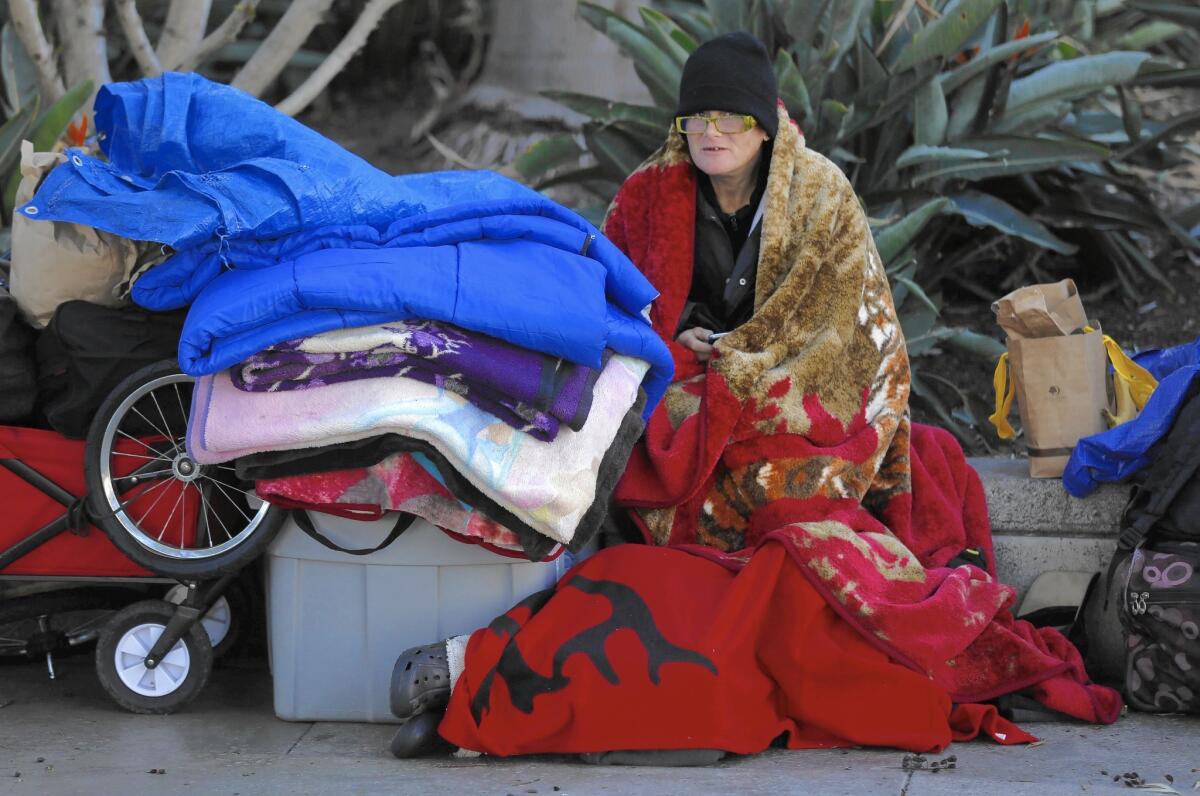Column: Compassion, confusion and resentment in a city where the homeless are everywhere

Homeless for the past eight years, Melissa Barrett uses extra blankets to guard against the cold weather while her friend Theresa Sedillo sleeps at her feet at the Santa Ana Civic Center.
- Share via
I’ve taken to carrying dog food in my car, stocking the back seat with the free samples of kibble I get when I buy the big bags.
That’s because I can’t bear to ignore the guy who’s always begging at my freeway offramp with his cute little mutt.
And because I’ve never been sure the dollar bills I’ve given him went toward dog chow rather than drugs.
I don’t know if my thinking is right or warped.
Am I favoring an animal’s needs over a human’s? Is that puppy really just a prop? Should I donate only to homeless services groups to discourage panhandling — or give freely without judgment?
I know I’m not the only one wrestling with feelings of compassion, confusion and resentment.
It was easier to be generous and feel good about it when we didn’t see homeless people everywhere: camping on sidewalks and in parks; soliciting captive crowds on rush-hour Metro trains; standing outside upscale markets with sad-faced children and “Please Help Us” signs.
Now every area has its own cadre of panhandlers and version of encampments. And we’re all bound to be touched by their presence — whether they prick your conscience or stoke your cynicism.
The number of homeless people in Los Angeles County has grown by 12% in the last two years. But the number of tents, makeshift communities and vehicles occupied by homeless people has jumped by 85%.
The dispossessed no longer gravitate to shelter-centric skid row, where crime is high, living quarters are tight and mental illness and drug abuse turn everyday rituals into tension-filled encounters. Instead, almost 10,000 of the county’s 44,000 homeless people are living in cars, tents and RVs and staking their claim to public spaces such as beaches, riverbeds, sidewalks and parks.
That’s given every neighborhood a stake in the problem and provided a barometer of how sad and dangerous things have become.
And it’s prompting residents — frustrated, fearful and tired of waiting for elected officials to do more than talk — to take matters in their own hands.
::
In Pacific Palisades, residents are pooling their money and waging a $500,000 fundraising campaign to hire outreach workers, arrange mental health and drug abuse treatment, and find housing options — most likely outside the pricey seaside community — for the 200 or so homeless people who have been camping on the beach or living in the brush.
In Porter Ranch, homeowners just want to run them off, concerned that crime will rise and the value of their property will drop if homeless people are allowed to hang around. A string of decrepit recreational vehicles parked on a main street near upscale homes has sparked an online campaign for resident-only parking.
“I didnt pay a million dollars for a homeless to live on the street for free in an ugly rv,” one neighbor wrote.
San Pedro’s corresponding symbol of blight was a crop of tiny wooden homes on wheels. The boxlike shelters, built on a model pioneered in South Los Angeles, were erected last summer by community activists. But opposition from residents and city officials soon got them carted off.
“These shacks are not the solution to end homelessness in our city,” Councilman Joe Buscaino said then.
The problem is that no one seems to know what the solution is.
In September, officials spent more than a week and $300,000 removing 163 tons of trash from an encampment on city-owned land in Sunland’s Tujunga Wash. The homeless campers were offered temporary shelter, but almost all refused. Many resettled instead on a neglected patch of privately owned land about a mile upstream from Hansen Dam.
That led frustrated homeowners in a nearby enclave to stage their own cleanup this month. More than 100 volunteers rented a skip-loader, donned gloves and masks and swept through the squatters camp, as Times reporter Doug Smith chronicled the cleanup project.
The volunteers hauled away piles of clothing, mattresses, dressers, hypodermic needles and a big-screen TV. And whatever compassion they might have felt for their homeless neighbors was buried by the residue.
“Homeless,” the crew leader said, is just a “euphemism for people who are breaking into our cars, trying to break into our homes, selling drugs.
“I’m not safe in my own neighborhood.”
::
For years, while the housing crisis brewed and the homeless population grew, the pendulum in Los Angeles swung from heartless crackdowns to unrealistic promises of shelter for all.
Now rising tensions and threats of violence — particularly in tourist areas — are drawing so much attention, city officials can’t afford not to act.
Last summer In Venice, a hotel owner was arrested and charged with murder for allegedly directing a gunman to shoot into a crowd of homeless people he’d argued with outside his beachfront hotel. A man, whose friends said he was trying to mediate the dispute, was shot to death; another homeless man was injured.
And on Thursday in Hollywood, actress Pauley Perrette was attacked while crossing a street near her home by someone she described on Twitter as “VERY psychotic.” A 45-year-old homeless man was arrested later that night and charged with two felony counts of punching and threatening to kill Perrette.
Two months ago, the Los Angeles City Council said it would declare a “state of emergency” on homelessness and dedicate $100 million to fix it. Today we’ll see if it actually intends to put some muscle behind the pledge.
On the table are proposals to open more shelters on public land, loosen the reins on private groups that want to offer space and let homeless people sleep in their cars and vans in designated parking lots.
That won’t provide much help to people with no place to live — but it might offer a little relief to beleaguered neighborhoods.
Twitter: @SandyBanksLAT
MORE FROM SANDY BANKS:
A dose of reality on homelessness
L.A. leaders’ lofty goals are at odds with reality
How some teens learn to sustain hope ‘when times are hard’
More to Read
Sign up for Essential California
The most important California stories and recommendations in your inbox every morning.
You may occasionally receive promotional content from the Los Angeles Times.











